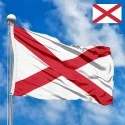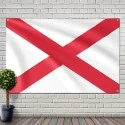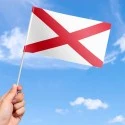The Flag of Saint Patrick, often referred to as Saint Patrick's Saltire or Saint Patrick's Cross, is one of Ireland's most recognizable, yet debated, symbols. This flag features a red diagonal cross (saltire) on a white background. In heraldry, it is blazoned as "Argent, a saltire gules." Its history and meaning are deeply intertwined with the figure of Ireland's patron saint, Saint Patrick, as well as with the history of Ireland itself and its connections to Great Britain.
Description and Elements of the Flag
The Flag of Saint Patrick has a very simple, yet profoundly symbolic design:
-
Red Saltire (Diagonal Cross): This diagonal cross, also known as Saint Andrew's Cross in the case of Scotland, extends across the entire flag. The color red is traditionally associated with martyrdom and self-sacrifice.
-
White Field: The white field of the flag symbolizes purity, peace, and innocence. In heraldry, white (argent) often serves as a base for other colors.
Unlike many other national symbols, the Flag of Saint Patrick does not contain complex elements, coats of arms, or additional images. Its strength lies in its simplicity and recognizability, allowing it to be easily integrated into more complex compositions, such as the Union Jack.
Dimensions, Colors, and Placement of Elements
The standard proportions of the Flag of Saint Patrick are typically 1:2 or 3:5, consistent with generally accepted flag standards. The red saltire is evenly distributed across the white field, extending from corner to corner. The thickness of the cross's bands is proportional to the flag's size, ensuring its visual balance.
The heraldic blazon "Argent, a saltire gules" means that on a silver field (white), there is a red saltire (diagonal cross).
History of Creation and Adoption of the Flag
The history of the Flag of Saint Patrick is a subject of much discussion and dispute. Although Saint Patrick lived in the 5th century, the association of the red saltire with him appeared much later, only in the late 18th century.
The most widely accepted theory suggests that the flag was first used by the Order of Saint Patrick, a chivalric order established by King George III in 1783. This order was created for the Irish aristocracy to strengthen loyalty to the British Crown amid growing nationalist sentiments in Ireland. The Order adopted this red saltire on a white field as its emblem, and it has since become associated with Saint Patrick and, consequently, with Ireland.
However, other theories of origin exist. Some researchers suggest that the red saltire might have been taken from the coat of arms of the powerful Irish Fitzgerald (Geraldine) dynasty, which played a significant role in Irish history for centuries. Other sources indicate that a similar design with a red saltire on a white background appeared on some Irish maritime flags and ensigns as early as the 17th century, long before the establishment of the Order of Saint Patrick. For example, some atlases and flag books from the late 17th and 18th centuries depict a red saltire on white for Ireland.
A crucial moment in the flag's history was its incorporation into the Union Jack in 1801 when the Kingdom of Ireland united with the Kingdom of Great Britain to form the United Kingdom of Great Britain and Ireland. To create the new flag of the United Kingdom, the red saltire of Saint Patrick was added to the Cross of Saint George (red straight cross on white, symbol of England) and the Saltire of Saint Andrew (white saltire on blue, symbol of Scotland). This fact underscores that British authorities recognized this symbol as representing Ireland.
Country, Region, and Interesting Facts
The Flag of Saint Patrick is associated with the island of Ireland as a whole. Ireland, located in northwestern Europe, is divided into the Republic of Ireland (an independent state) and Northern Ireland (part of the United Kingdom).
-
Symbol of Neutrality: In Northern Ireland, the Flag of Saint Patrick is sometimes perceived as a more neutral symbol compared to the Irish Tricolour (which is associated with republicans/nationalists) and the Ulster Banner (which is associated with loyalists/unionists). It is used in some institutions that aim to avoid direct political connotations.
-
Union Jack: The most prominent use of the Flag of Saint Patrick today is its inclusion in the design of the Union Jack, making it part of one of the world's most famous flags.
-
Disputed Origin: The lack of clear historical evidence directly linking the saltire design to Saint Patrick himself leads to controversy among historians and vexillologists. Some Irish nationalists reject the Flag of Saint Patrick as a "British invention" with no authentic Irish origin.
-
Saint Patrick's Day: Despite the disputes, the Flag of Saint Patrick is often used during Saint Patrick's Day celebrations, especially outside Ireland, as a general symbol of Irish heritage.
-
Similarity to Other Flags: The design of the Flag of Saint Patrick is similar to some other flags, for example, the flag of the U.S. state of Alabama. However, this similarity is usually coincidental and not related to the Irish symbol.
-
Early Irish Symbols: Before the appearance of the saltire, Ireland traditionally used symbols such as the golden harp on a blue or green background. Green and the harp remain powerful and widely accepted Irish symbols.
Significance for Residents
The significance of the Flag of Saint Patrick for the residents of Ireland and the Irish diaspora is ambiguous and multifaceted.
-
Symbol of the Patron Saint: For many, especially in Northern Ireland and among unionists, the Flag of Saint Patrick symbolizes Saint Patrick as the patron saint of the entire island of Ireland. It represents a historical link with the British Crown and Ireland's role within the United Kingdom.
-
National Identity (Controversial): While some see it as a symbol of Irish identity, particularly in the context of Saint Patrick's Day celebrations, many Irish nationalists and residents of the Republic of Ireland do not consider it their national flag. For them, the Irish Tricolour (green, white, orange) is the true symbol of independent Ireland and its aspiration for unity. The Tricolour was adopted by the Irish Free State in 1922 and officially enshrined in the Constitution of Ireland in 1937.
-
Historical Heritage: For those who value Ireland's historical ties with Great Britain, the Flag of Saint Patrick serves as a reminder of the period when Ireland was part of the United Kingdom. Its presence in the Union Jack symbolizes this historical union.
-
Diaspora Symbol: Outside Ireland, especially in countries with large Irish diasporas, the Flag of Saint Patrick is often used alongside the Tricolour as a general symbol of Irish culture and heritage, particularly during Saint Patrick's Day. It can be less politically charged than the Tricolour and therefore more acceptable to a wide range of people celebrating Irish ancestry.
-
Diverse Interpretations: Overall, the meaning of the Flag of Saint Patrick heavily depends on an individual's political views and historical perspective. It is a symbol that can evoke both a sense of belonging and historical pride, as well as controversy and disagreement, reflecting Ireland's complex and multifaceted history.
In the demonstration images, full-size flags are shown with proportions of 2:3, and hand-held flags with proportions of 1:2.






 Waving flag
Waving flag
 Sizes:
Sizes:
 Round flag
Round flag
 Sizes:
Sizes:
 Rectangular flag 2:3
Rectangular flag 2:3
 Sizes:
Sizes: